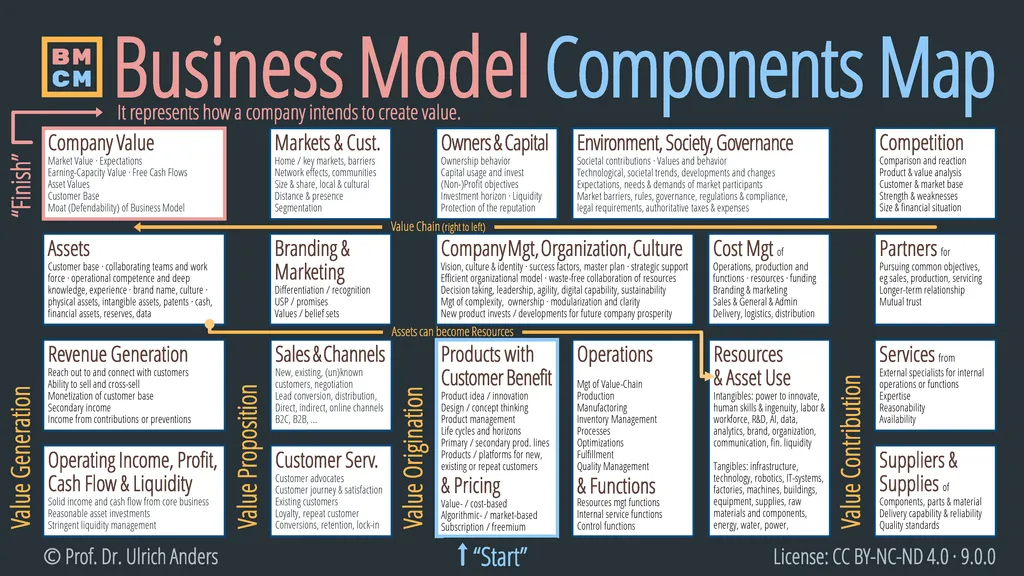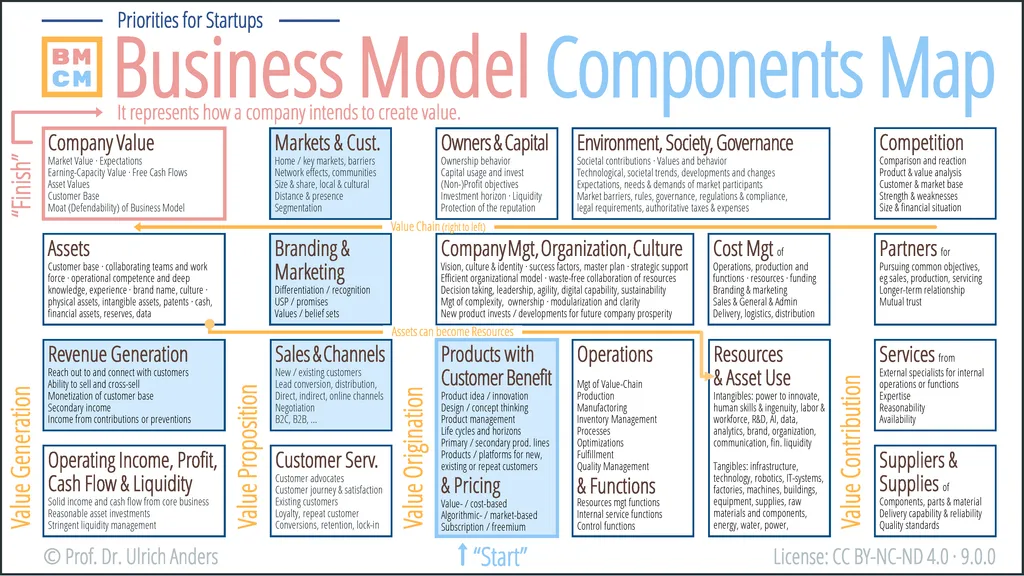Business Models

On the link you will find a PDF-file with different versions for analysing, planning or designing a business model. There is also a German PDF-file.
What is a Business Model?
A business model represents how a company intends to create value. At the center of a business model is the product or the set of products that produce customer benefit. A business model requires from a company to describe its approach to revenue generation. Revenue is a function of the product price and the amount of customers buying the products. The company further needs to specify on which markets its wants to operate and to define how it plans to market its products, i.e. how to reach the customers and inform them about the products by help of marketing or branding. In the business model, the company also defines the channels for selling the products or set of products.
The business model further requires from a company to formulate its approach to managing the costs incurred for operations and production, delivery, logistics and distribution, branding and marketing, sales and administration, as well as funding.
The purpose of any company is to continuously create valuable products that have customer benefit (the WHAT) from organizing the utilization of resources (the HOW). In order to achieve this the company management needs to decide which resources are necessary internally or externally, and how to structurally and systemically organize all of these in order to reach the company objectives. Also company management needs to define how it positions itself in the context of the environment, society, or governance.
The Business Model Components Map
The Business Model Components Map (BMCM) has been designed as a map that displays the most relevant components of a business model in an orderly manner. All components are grouped in four areas:
-
Value Generation: the (market) value of a company is generated by the investors’ Expectations, its ability to have Earning Capacity (now or in the future), by its Free Cash Flow, by accumulating Asset Values, by building a Customer Base and by the Defendability (Moat) of the business model. Successful companies built Assets over time. This is achieved through the results of work and through Revenue that after subtracting costs yield Operating Income, Profits and Cash Flow while contributing to the Liquidity of the company.
-
Value Proposition: the Products of a company have only value if they provide Benefit for a defined Pricing to the customers and the latter eventually want to exchange money (or data) to get the products. For that reason the Customer Relationship is key and companies not only have to attract customers but also retain them. As a consequence, companies need to look closely at which Customers segment they are approaching in which Market and for what Price they want to sell the products over which Channel. Marketing and Branding are necessary to attract and retain customers.
-
Value Origination: at the core of a company are its products. Resources include Assets that the company was already able to build up previously. Every product needs to be produced and this takes place the company’s operations supported by business functions. All of this needs to be directed and organized by the Company Management which is a layer above. Using Resources and carrying out work in Operations & Functions incur Costs that need to be managed. In order to work successfully a company also must consider its context of Environment, Society, and Governance. The company itself is owned by its Owners and uses Capital to operate. The behavior of owners and capital play a significant role in the business model, e.g. when investments are long term vs when cash is withdrawn from the company.
- Value Contribution: companies are not stand-alone entities. They generally require Supplies and Services from third parties. Sometimes companies build Partnerships with other companies or enter into joint ventures. Partners, servicers and suppliers all directly contribute to the value origination or value proposition. The Competitors, in contrast, indirectly contribute by adding to a market environment in which customers can choose or by offering alternative products that constantly force the company to innovate or improve.
Each of these areas contain four components. Only Value Origination contains seven components. Each component itself has many elements that often need to be considered in the components. The components help to break down the business model into 19 parts. They are all connected, but can otherwise be analysed or viewed separately in order to reduce complexity.
One can use the Business Model Components Map to analyse a business model of a company, to benchmark one business model against another, to develop a business model for a startup, to further enhance an existing business model, or as a checklist to start the discussion of some relevant points within each element of a business model.
In addition, one can also use the Business Model Components Map to locate certain projects, for carrying out project work, for understanding, which components or elements of a business model need to be improved, or for building an M&A-case that results from generating synergies in one or more components.
What is a Working Business Model?
A Business Model is working if it eventually creates value and this value creation allows the business model to become self-sustained. The company that employs the business model is not burning equity and doomed to fail.
In contrast, a business model does not work if it does not create value. Either it does not generate significant revenue, it fails to attract a significant number of customers, or it does not succeed to monetize customer relationships in an overall satisfactory manner.
Business Models for Startups

To formulate and achieve a fully blown Business Model is a complex, cumbersome, and time consuming tasks. For that reason, it is important for a Startup to focus on the most relevant components of a business model, which are the components that are in direct connection with the customer (displayed with light blue background in the picture). This is first of all the core product that must generate customer benefit.
The further essential components for startups are the definition of the customer segments and the markets in which to target these customer segments, the branding and marketing approach to reach the customers and for revenue generation the channels to be used.
What are Digital Business Models?
The term Digital Business Models can mean several things:
-
Already existing business models, in which functions, processes, resources, assets, market access, etc. are enhanced or supplemented by digital technologies (e.g. automation, AI, robotics, [big] data collection and analysis). This is also commonly referred to as digital transformation of business models.
-
Business models in which companies offer services around or with digital solutions. The advantage of these business models result from economies of scope and is typically B2B. The expertise of the company is applied to many client companies. Since the products are digital the company must not be physically present at the client companies. If this is the case, travel expenses fall away and the services can be offered internationally. However, because the services are typically customer individual such business models are more difficult to scale because more customers generally require more employees.
-
Business models in which companies offer high quality open source, free or rather cheap solutions in order to attract a large customer base. Customers from the customer base can then receive group or individual services, coaching, consulting typically in conjunction with the free content.
-
Business models in which companies offer digital products. The advantage of these business models result from economies of scale. A principally identical digital product can be sold to many customers. Such business models are typically B2C.
-
Business models in which companies do not offer products themselves. Instead they offer platforms on which products can be traded, bought or sold. The platforms offer their customer an efficient access to a large market. In times of tight global markets the value of an increasing amount of companies results less from its ability to produce but more from its ability to sell. Therefore the advantage of these business models results from having a strong customer connect. Such business models can be both B2B and B2C.
What are New or Innovative Business Models?
According to the definition, the logic with which a company strives to create value is represented by its business model. The components of a business model are always the same. A new or innovative business model, therefore, is when companies do at least one innovation in any of the components of the business model and if this eventually leads to the generation of value, to more revenue, or to less costs.
One example: classically, revenue is generated by selling products or services. In newer, but by all means not new any more, business models companies offer the product or service for free. The revenue is then created by help of monetizing the customer connection, e.g. through advertising or through the sale of insights from customer data.
The huge values of a now significant number of companies no longer stem from the value of their substance or from their ability to generate profits and cash flows, but from their large number of customer connections which are assumed to be monetized at some point in time in the future.